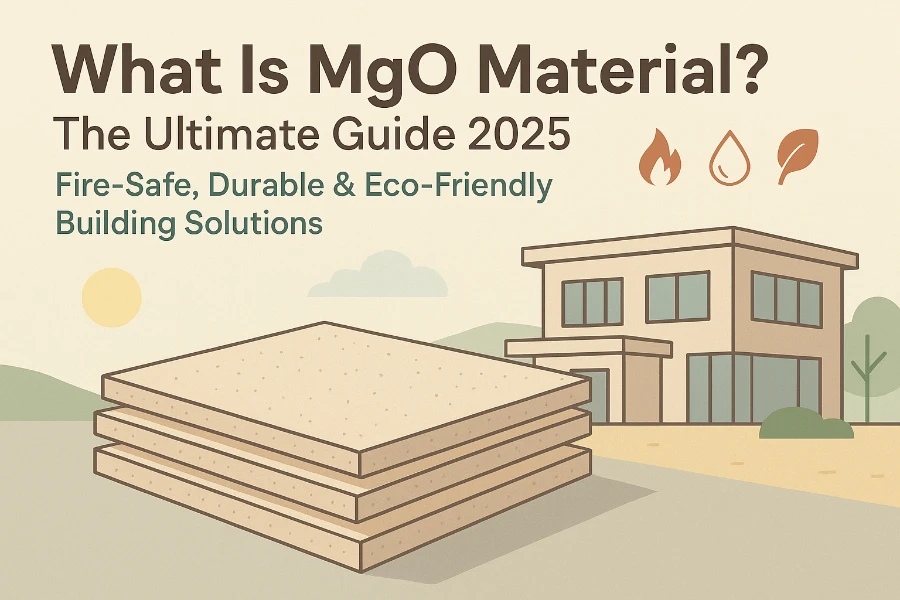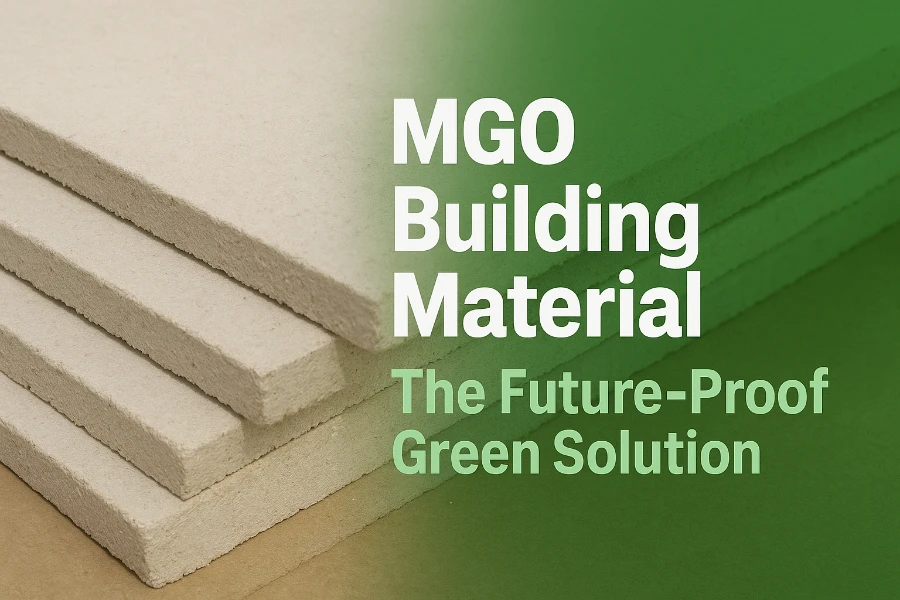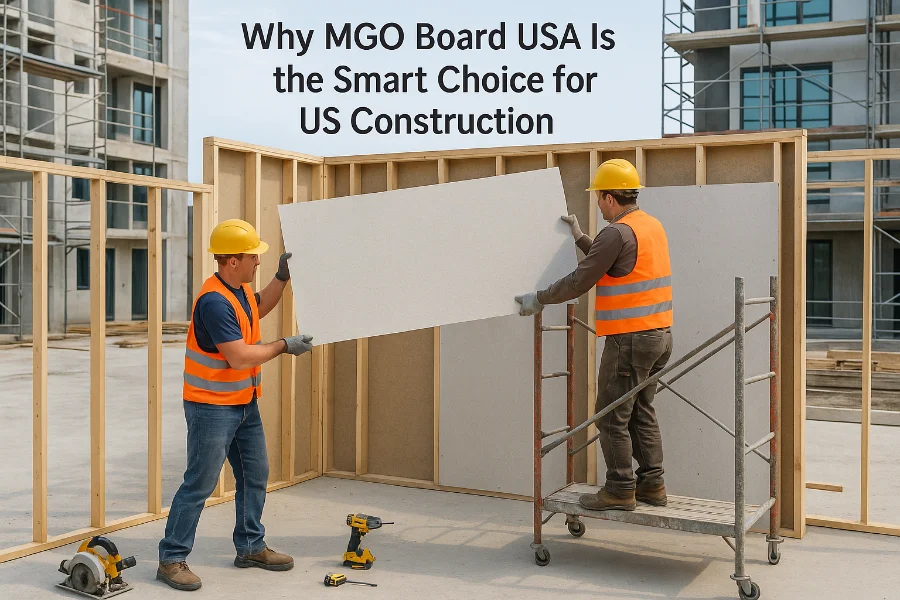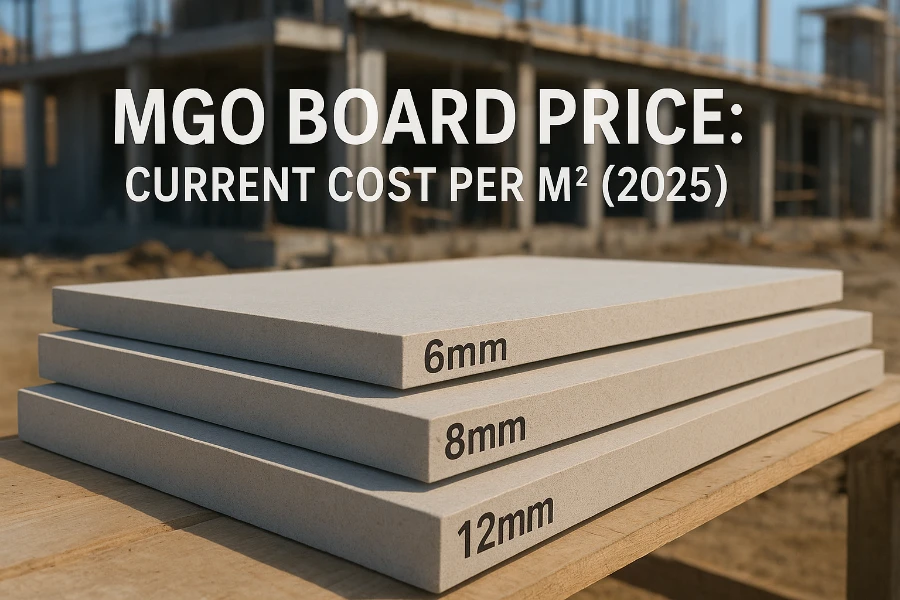Table of Contents
1. Introduction
In the rapidly evolving construction industry, new materials are constantly emerging to meet the demands for safety, sustainability, and efficiency. Among these, magnesium oxide, commonly referred to as MgO, has gained significant attention. Builders, architects, and homeowners are beginning to recognize its versatility and the unique advantages it offers over traditional materials like gypsum and cement board.
As we move into 2025, the question “What is MgO material?” is becoming increasingly relevant. With growing emphasis on fire safety, green building, and long-lasting structures, MgO materials are stepping into the spotlight as a smart choice for modern construction. This guide explores what MgO is, its properties, applications, and why it matters more than ever in today’s building industry.
2. What Is MgO Material?
Definition
Magnesium oxide (MgO) is an inorganic compound composed of magnesium and oxygen. In its pure form, it appears as a white, powdery substance that can be calcined at high temperatures to form a stable, durable material.
In the construction world, MgO is most commonly used in the form of magnesium oxide boards (MgO boards). These boards serve as an alternative to traditional wall sheathing, flooring substrates, and ceiling panels. They are prized for their fire resistance, structural strength, and resistance to moisture and mold.
Beyond Construction
Although MgO is best known in the building industry, its uses extend far beyond construction. It is widely employed in:
-
Agriculture: as a soil stabilizer and animal feed additive.
-
Industrial processes: in refractory bricks, ceramics, and chemical production.
-
Healthcare: as a component in pharmaceuticals and dietary supplements.
This versatility makes MgO a material with global importance, bridging industries as diverse as housing, farming, and medicine.
3. Composition and Properties of MgO
Composition of MgO
Magnesium oxide originates primarily from magnesite (MgCO₃), a naturally occurring mineral. When magnesite is subjected to high-temperature calcination—usually between 700°C and 1000°C—it decomposes into magnesium oxide and carbon dioxide. The resulting MgO powder is then processed into different forms depending on the intended use.
In building materials, MgO is mixed with other components such as perlite, fiberglass mesh, or wood chips to enhance strength and performance. This combination allows manufacturers to produce versatile MgO boards that can meet varying engineering requirements.
Physical Properties
Magnesium oxide is known for a unique set of physical characteristics that distinguish it from traditional building materials:
-
High melting point: MgO has a melting point above 2800°C, making it highly heat resistant.
-
Excellent compressive strength: Suitable for load-bearing applications when engineered into board form.
-
Lightweight structure: Easier to transport and install compared to cement boards.
-
Dimensional stability: Less prone to warping or shrinking under changing humidity conditions.
Chemical Properties
From a chemical perspective, MgO displays several features that make it attractive in construction and beyond:
-
Alkalinity: Provides natural resistance to mold, mildew, and insects.
-
Non-combustible: Classified as a fireproof material under international standards.
-
Compatibility: Works well with paints, finishes, and laminates such as PVC films.
-
Durability: Chemically stable, with low reactivity under normal environmental conditions.
Why These Properties Matter
The combination of high fire resistance, durability, and environmental compatibility explains why MgO materials are gaining traction in 2025. Builders and architects see them as an advanced alternative that reduces long-term risks while supporting sustainability goals.
4. Manufacturing Process of MgO Materials
1. Raw Material Preparation
The production of MgO materials begins with sourcing high-quality magnesite or other magnesium-containing minerals. These raw materials are carefully crushed and screened to achieve uniform particle size. Impurities are removed to ensure consistent chemical composition, which is critical for the final product’s durability and fire resistance.
2. Calcination
Calcination is the process of heating magnesite to high temperatures (usually 700–1000°C) to decompose magnesium carbonate (MgCO₃) into magnesium oxide (MgO) and carbon dioxide (CO₂). The calcination temperature and duration directly affect the MgO’s reactivity and crystallinity, which in turn impacts the board’s strength and setting time.
3. Mixing and Additives
After calcination, MgO powder is mixed with water, binders, and other additives such as perlite, wood chips, or fiberglass mesh. This step tailors the material’s properties—enhancing fire resistance, moisture resistance, and mechanical strength. Proper proportioning is essential to maintain board uniformity and prevent defects like cracking or delamination.
4. Forming and Pressing
The prepared mixture is then formed into boards or panels using molds and pressing equipment. This step determines the thickness, density, and surface smoothness of the MgO board. Consistent pressure ensures optimal bonding of components, which is crucial for load-bearing performance and dimensional stability.
5. Curing and Drying
After pressing, the boards undergo a controlled curing and drying process. Some manufacturers use steam or autoclave curing to accelerate setting, while others rely on ambient or kiln drying. Proper curing prevents warping, shrinkage, and micro-cracks, ensuring that the final MgO boards maintain their strength and longevity.
6. Quality Control and Finishing
Finally, boards are inspected for uniformity, thickness, and surface quality. Edges may be trimmed, and surfaces sanded or treated to improve adhesion with paints, laminates, or finishes. Certification tests may also be conducted to comply with international standards like ASTM, EN, or CE.
7. Emerging 2025 Trends in Manufacturing
In 2025, manufacturers are increasingly adopting low-carbon production methods, incorporating recycled content, and optimizing calcination processes to reduce energy consumption. Innovations such as improved fiber reinforcement and precision automated pressing are helping MgO boards achieve higher durability and better environmental performance.
5. Key Uses of MgO Material in Construction
1. Interior and Exterior Walls
MgO boards are widely used as wall sheathing for both interior and exterior walls. Their excellent fire resistance and moisture-proof properties make them ideal for residential, commercial, and industrial buildings. Compared to traditional gypsum boards, MgO walls are more durable, resist mold growth, and offer superior sound insulation.
2. Flooring and Subflooring
MgO boards serve as a robust subflooring material under tiles, vinyl, or laminate flooring. Their high compressive strength ensures structural stability, while moisture resistance prevents warping and mold, especially in humid environments. Unlike cement boards, MgO boards are lighter and easier to cut, reducing installation time and labor costs.
3. Roofing Systems
In roofing applications, MgO boards act as a protective layer under roof tiles or membranes. Their fireproof nature enhances building safety, and their lightweight composition helps reduce overall roof load. MgO boards also resist decay from weather exposure, extending the lifespan of the roofing system.
4. Partitions and Ceilings
MgO materials are ideal for creating partitions, suspended ceilings, and false ceilings. They are easy to install, cut, and shape, offering flexibility for modern interior design. Their fire resistance and dimensional stability make them a safer and more durable choice than gypsum or plywood panels.
5. Structural Insulated Panels (SIPs)
MgO boards can be used in SIPs, combining insulation materials like foam with MgO facings. This creates highly energy-efficient panels with excellent thermal performance, fire safety, and structural integrity. MgO SIPs are increasingly favored in sustainable building projects and prefabricated constructions.
6. Advantages Over Alternative Materials
-
Vs. Gypsum Board: Superior fire resistance, moisture resistance, and durability.
-
Vs. OSB/Plywood: Higher fire safety, resistance to mold and insects, and better dimensional stability.
-
Vs. Fiber Cement Board: Lighter, easier to handle, and more environmentally friendly.
MgO boards not only match or exceed the performance of conventional materials but also contribute to sustainability goals, making them a smart choice for 2025 construction projects.

6. Benefits of Using MgO Materials
1. Fire Resistance
One of the most significant advantages of MgO materials is their exceptional fire resistance. MgO boards are non-combustible and can withstand extremely high temperatures without releasing toxic fumes. For builders asking “what is mgo material and why use it?”—fire safety is often the top reason. This makes MgO boards ideal for walls, ceilings, and floors in residential, commercial, and industrial buildings.
2. Durability
MgO boards offer long-term durability compared to traditional materials. They resist cracking, warping, and sagging, even in high-humidity or temperature-fluctuating environments. Their structural integrity ensures that walls, partitions, and panels maintain their performance over decades, reducing maintenance costs and replacement frequency.
3. Moisture and Mold Resistance
Unlike gypsum boards, MgO boards are highly resistant to moisture and mold. This property is especially important in bathrooms, kitchens, and basements. Builders often choose MgO boards for areas prone to dampness because they maintain stability and do not promote microbial growth, ensuring a healthier indoor environment.
4. Sustainability
MgO materials are environmentally friendly. They are often made from naturally abundant minerals and can include recycled content. Moreover, MgO boards are fully recyclable at the end of their life cycle. For companies and homeowners focused on green building, understanding “what is mgo material” also means recognizing its role in reducing environmental impact and supporting sustainable construction practices.
5. Cost-Effectiveness
While the initial cost of MgO boards may be slightly higher than traditional gypsum or plywood, their long-term benefits outweigh the upfront investment. Reduced maintenance, longer lifespan, and improved safety contribute to overall cost-effectiveness. Builders and architects increasingly recognize MgO materials as a smart, long-term choice for construction projects in 2025 and beyond.
6. Compatibility with Finishes
MgO boards are compatible with a wide range of paints, coatings, and laminates. Their smooth surface allows for easy finishing and decorating, making them versatile for both aesthetic and functional applications. This adaptability reinforces the value of understanding “what is mgo material” for modern interior and exterior design.
7. Comparison With Alternative Materials
1. MgO vs. Gypsum Board
Gypsum board is widely used for interior walls and ceilings, but it has limitations in fire resistance and moisture durability. In contrast:
-
Fire Safety: MgO boards are non-combustible and withstand higher temperatures.
-
Moisture Resistance: Unlike gypsum, MgO boards do not swell, warp, or promote mold growth in humid environments.
-
Strength and Durability: MgO boards maintain structural integrity over time, offering a longer service life.
Builders asking “what is mgo material” often find this comparison highlights why MgO is a safer, longer-lasting alternative for critical applications.
2. MgO vs. Cement Board
Cement boards are another popular alternative, particularly for wet areas like bathrooms or kitchens. Compared with cement boards:
-
Weight: MgO boards are lighter, making handling and installation easier.
-
Surface Finish: MgO provides a smoother, more uniform surface suitable for paints and laminates.
-
Environmental Impact: MgO production typically has a lower carbon footprint than cement-based products.
3. MgO vs. Wood-Based Panels (OSB, Plywood)
Wood-based panels are common for subflooring, partitions, and SIPs. However:
-
Fire Resistance: MgO boards outperform wood panels, which are combustible and prone to smoke emission.
-
Moisture and Mold: MgO boards resist water damage and mold, while wood panels may rot or swell.
-
Long-Term Stability: MgO maintains dimensional stability, whereas OSB and plywood can warp with humidity changes.
4. Why Builders Are Switching to MgO
The combined advantages of fire safety, moisture resistance, durability, and sustainability make MgO boards increasingly preferred over traditional alternatives. As the construction industry embraces green building and resilient structures in 2025, understanding “what is mgo material” becomes crucial for architects, contractors, and developers.
8. Beyond Construction: Other Applications of MgO
1. Agriculture
MgO plays an important role in modern agriculture:
-
Soil Improvement: MgO is used to correct acidic soils, providing essential magnesium for healthy plant growth.
-
Animal Feed Additive: It acts as a dietary supplement for livestock, promoting better digestion and nutrient absorption.
-
Pest and Disease Resistance: Its alkalinity helps reduce soil-borne pathogens, contributing to crop protection.
2. Industrial Uses
MgO is widely applied in various industrial processes:
-
Refractory Material: Due to its high melting point, MgO is used in furnaces, kilns, and other high-temperature equipment.
-
Chemical Production: MgO serves as a raw material in producing magnesium-based chemicals, fertilizers, and catalysts.
-
Ceramics and Glass: It enhances thermal stability and strength in ceramic and glass manufacturing.
3. Healthcare and Pharmaceuticals
In the medical field, MgO has multiple applications:
-
Antacids and Laxatives: Magnesium oxide is commonly used to relieve heartburn and constipation.
-
Dietary Supplements: It provides an essential source of magnesium for human health.
-
Medical Materials: Its biocompatibility allows use in some biomedical applications like wound dressings and implants.
4. Environmental Applications
MgO contributes to sustainability and pollution control:
-
Flue Gas Treatment: It is used in desulfurization processes to reduce SO₂ emissions from power plants.
-
Wastewater Treatment: MgO neutralizes acidic water and removes heavy metals.
-
Adsorbent: It serves as an effective material for capturing pollutants and harmful gases.
5. Why This Matters in 2025
As industries focus more on sustainability, efficiency, and safety, the versatility of MgO becomes a key advantage. Beyond construction, its wide-ranging applications in agriculture, industry, healthcare, and environmental protection underline its global importance, further reinforcing the relevance of understanding “what is mgo material” today.
9. Challenges and Considerations
1. Cost Factors
While MgO boards offer long-term benefits, their initial cost can be higher than traditional materials like gypsum or plywood. This upfront investment may be a concern for budget-conscious projects. However, the durability, fire safety, and reduced maintenance often justify the higher initial expenditure over the lifecycle of a building.
2. Market Awareness
Despite its advantages, MgO materials are still less known in certain regions. Many architects, contractors, and homeowners may not fully understand “what is mgo material” or its performance benefits. Increasing education, marketing, and demonstration projects are crucial for wider adoption.
3. International Certifications and Standards
Compliance with global standards such as ASTM, EN, or CE is essential for MgO materials used in construction, especially for export markets. Some manufacturers may not meet all certification requirements, which can limit market access. Understanding certification status and quality testing is necessary before specifying MgO products.
4. Supply Chain and Quality Variations
The performance of MgO boards can vary based on raw material quality, production processes, and manufacturer expertise. Variations in density, composition, or curing can affect fire resistance, moisture performance, and structural integrity. Buyers must ensure consistent quality through trusted suppliers, proper inspections, and adherence to production standards.
5. Handling and Installation Considerations
Although MgO boards are easier to cut and install than cement boards, proper handling is still required to avoid chipping or cracking. Installation best practices, including using appropriate fasteners, adhesives, and finishing techniques, are critical for maximizing the material’s lifespan and performance.
10. Future of MgO Material in 2025 and Beyond
1. Global Green Building Trends
Sustainability continues to shape the construction industry. MgO materials align well with green building initiatives due to their low environmental impact, recyclability, and long lifespan. As governments and developers increasingly adopt eco-friendly standards, MgO boards are expected to see wider adoption in energy-efficient, low-carbon construction projects.
2. Role in Carbon Neutrality
MgO production can be adapted to reduce CO₂ emissions compared with traditional cement-based products. By incorporating recycled content and optimizing calcination methods, manufacturers contribute to carbon neutrality goals. Understanding “what is mgo material” now includes recognizing its potential to support climate-friendly construction practices.
3. Emerging Technologies
Innovation in 2025 is driving MgO material advancements:
-
Low-Carbon Production: New calcination techniques reduce energy consumption and greenhouse gas emissions.
-
Enhanced Composites: Improved fiber reinforcements and additives increase board strength, fire resistance, and moisture protection.
-
Prefabrication and Modular Construction: MgO boards are increasingly integrated into SIPs, modular panels, and ready-to-install components, streamlining construction timelines and reducing waste.
4. Expanding Global Markets
As awareness of MgO’s benefits grows, international markets are opening up. Regions with high fire safety requirements, humid climates, or green building incentives are expected to adopt MgO materials more widely. Manufacturers investing in certifications and quality assurance will be well-positioned to meet this global demand.
5. Long-Term Outlook
MgO materials are moving from niche applications toward mainstream building solutions. With continued research, improved production efficiency, and broader industry recognition, MgO boards are likely to become a standard choice for fire-safe, sustainable, and durable construction worldwide.
11. Conclusion
Magnesium oxide (MgO) materials have established themselves as a versatile and high-performance solution in modern construction. From exceptional fire resistance and durability to moisture-proof properties and environmental sustainability, MgO boards outperform many traditional building materials, including gypsum, cement, and wood-based panels. Beyond construction, MgO’s applications in agriculture, industry, healthcare, and environmental protection highlight its global significance.
Understanding “what is mgo material” today is not just about knowing its composition—it’s about recognizing the potential for safer, greener, and longer-lasting structures. As we move further into 2025, builders, architects, and developers have the opportunity to embrace MgO materials to meet modern demands for performance, safety, and sustainability.
If you are looking to enhance your next project with reliable, eco-friendly, and fire-safe building solutions, consider exploring MgO boards. Contact experienced suppliers or manufacturers to learn more about specifications, certifications, and installation best practices. Taking the step now ensures that your construction projects are prepared for the future of resilient and sustainable building.
Discover why MGO building material is the future-proof green solution for durable, fire-resistant, and eco-friendly construction projects.
Discover why MGO board USA is the smart choice for American construction—fire-resistant, durable, eco-friendly, and compliant with US building standards.
Discover the current MGO board price per m² in 2025. Learn factors affecting cost, compare with fiber cement boards, and get tips to save on your project.




